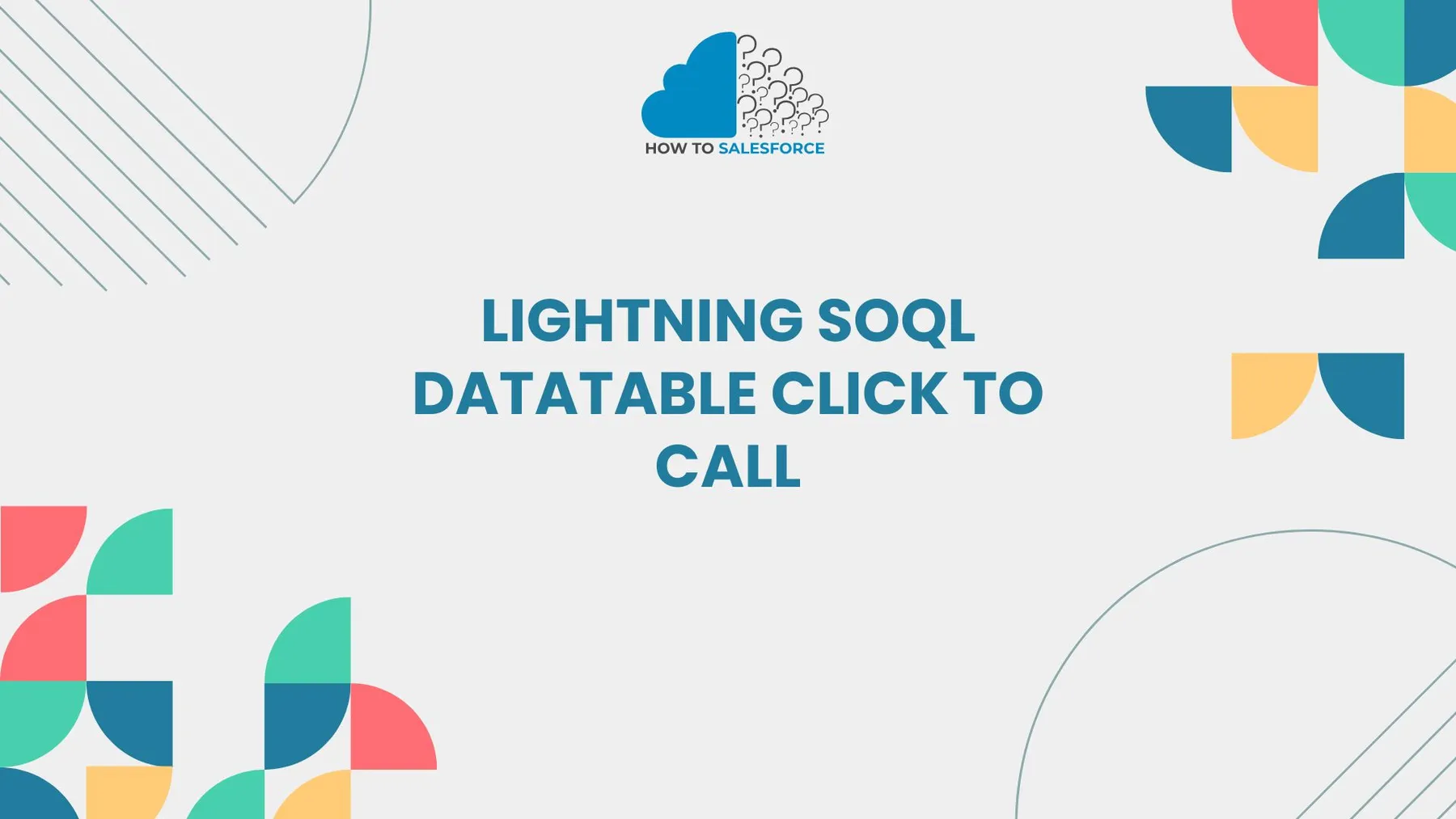Introduction
Lightning SOQL Datatable Click to Call allows Salesforce users to gain significant productivity gains. By enabling teams to make calls straight from a SOQL data table, this feature speeds up communication and enhances teamwork. The setup, configurations, troubleshooting, and optimization of click-to-call in Salesforce are all covered in this guide.
Want to read more? here’s my other blog: Integrate Salesforce with WordPress
What Is Lightning SOQL Datatable Click to Call
Firstly, the Lightning SOQL Datatable combines Salesforce’s SOQL Datatable with click-to-call functionality.. It makes outbound communication easier by allowing Salesforce users to make calls with a few clicks. This feature, which provides real-time access and eliminates the need to switch between apps, is extremely valuable for Salesforce administrators and developers who wish to create effective communication flows.
Salesforce’s click to call feature guarantees quick communication. Through integration with the Lightning SOQL Datatable, sales teams can shorten the time it takes to find a contact and call them. Improved client interactions, higher follow-up rates, and improved team performance can all result from this efficiency boost.
Benefits of Using Click to Call with SOQL Datatable
Furthermore, there are definite benefits to implementing click to call functionality in the SOQL Datatable, particularly for teams that depend on regular client interactions. These are the main advantages:
Improved Efficiency: Lightning SOQL Datatable Click to Call
Click to Call reduces the amount of time needed to make calls. Users can click on a contact instead of manually entering their number. This lowers friction and frees users to concentrate on important discussions rather than tiresome procedures.
Enhanced Productivity: Lightning SOQL Datatable Click to Call
By eliminating unnecessary steps, users can get to their clients more quickly. When team members aren’t juggling multiple platforms, productivity increases. Because click to call integration keeps everything in one place, users can focus on responsiveness and interaction quality.
Data Consistency: Lightning SOQL Datatable Click to Call
Salesforce automatically logs every call action, preserving a precise record of all conversations. Salesforce is a more dependable source for contact records and performance metrics because of this tracking, which keeps data current throughout the platform.
Better User Experience: Lightning SOQL Datatable Click to Call
Additionally, click to call features improve the experience for customers, service agents, and salespeople. Faster call access allows information to flow continuously, facilitating more responsive communication.
Setting Up Lightning SOQL Datatable Click to Call
In the Lightning SOQL Datatable, there are multiple steps involved in configuring the click to call feature. Every one of these actions guarantees that the integration runs smoothly:
Create a Custom SOQL Datatable
The first step is to create a SOQL data table that shows all pertinent data, including the call related fields. Include a phone number, contact name, and any other information that is necessary for productive client interactions in the required fields.
Write a SOQL query to retrieve the necessary information, such as contact or lead phone numbers, to accomplish this. For users to locate the call button with ease, make sure that these fields are prominently displayed in your data table.
Enable Click to Call on Phone Fields
Moreover, enable click-to-call on specific phone fields to initiate calls directly from the SOQL Datatable. Use Lightning Components to turn phone number fields into clickable buttons or links for this customization.
Creating a Lightning Web Component or embedding JavaScript functions are two ways to put this into practice. Verify that the feature is enabled in the phone number field of each record. Consistent functionality across records can be ensured by testing it on various contact types.
Test the Integration
Making sure click to call functionality functions properly requires testing. Once it is configured, start test calls from different records to make sure the integration works properly. Make sure that calls connect without any problems, and keep an eye on the data logs to make sure the call action is correctly captured.
Test every record and phone number format to prevent any problems when using the system in real-time. Additionally, make sure the call button is easily identifiable to users and that the interface is user-friendly.
Assign Permissions
The click to call feature is only accessible to pertinent team members thanks to appropriate permissions. Configure user profiles or permission sets to grant access to this feature to specific users.
Unauthorized access and accidental use can be avoided by restricting permissions to the profiles that are required. Additionally, it simplifies the interface for users who don’t need this feature, clearing out clutter.
Configure Call Logging
To track interactions, Salesforce’s automatic call logging is crucial. Set up call logging so that information like the call’s start time, duration, and status can be recorded. This process maintains an accurate log of every call, promoting data consistency and accountability.
Additionally, logging call details help with team performance tracking and report generation for management. Processes for customer service and sales can be greatly enhanced by these insights.
Key Components in Lightning SOQL Datatable Click to Call
Additionally, a smooth integration and better user experience can be ensured by being aware of each important component.
Phone Number Field
Essential to click to call functionality is the phone number field. Make sure all numbers have the same format for smooth calling.. For example, use common international formatting to ensure the system correctly recognizes the numbers.
Call failure may result from inconsistent formats. If the field format is the same for all contacts, you can prevent issues with unrecognized or invalid numbers.
Clickable UI Element
There should be a call button that is easily visible next to each phone number field. To make it simple for users to start a call with a single click, place the button right next to the phone number.
Create an intuitive user interface (UI) with labels or icons that convey the function of each button. By doing this, users can avoid inadvertently making calls or wasting time looking for the call button.
Logging Mechanism
Maintaining accurate data depends on the automatic logging mechanism. This feature records the contact, date, and length of each call. Make sure that these particulars are recorded without the need for user input.
Performance tracking relies heavily on accountability and transparency, which logging offers. Call logs can be examined by managers to gauge output and track the efficacy of communication.
Best Practices for Implementing Lightning SOQL Datatable Click to Call
Moreover, following best practices is necessary for the successful implementation of click to call functionality. These procedures guarantee a seamless user experience and dependable system performance.
Format Phone Numbers Consistently
To prevent call initiation problems, keep all phone numbers in Salesforce in the same format. Establish a common phone number format that all users must adhere to. Using a consistent format ensures reliable functionality and prevents errors.
Enable Automatic Call Logging
To automatically record every conversation, set up call logging. For accurate tracking and reporting, this step is crucial. Automated logging thoroughly records every call interaction by reducing user input.
Provide Team Training
Provide your team with training sessions to acquaint them with the click to call feature. Explain how to use the call button and check that calls log properly. By ensuring that users comprehend best practices, training increases output and lowers mistakes.
Monitor and Update Regularly
Maintain regular monitoring of the Lightning SOQL Datatable to ensure smooth operation. Check data fields, update permissions, and format all phone numbers correctly. Monitoring on a regular basis keeps the interface up to date with business requirements and helps avoid disruptions.
Troubleshooting Common Issues in Lightning SOQL Datatable Click to Call
Resolving frequent problems helps keep functionality high and avoid user annoyance.
Problem: Unable to Click on Phone Numbers
- Remedy: Ensure that the field in Lightning Components is configured to be clickable. To make sure the field is active, test it.
Problem: Erroneous Call Records
- Remedy: Verify again that the settings for automatic logging are turned on. Verify permissions to make sure logging is applicable to all pertinent users if issues continue.
Problem: Absence of Call Button
- Remedy: Check the user interface settings to position the call button correctly. Verify permissions for pertinent user profiles as well.
Problem: Formatting Issues
- Solution: Establish uniform phone number formatting and make sure all entries follow it.
Enhancing User Experience with Lightning SOQL Datatable Click to Call
Furthermore, enhancing user experience can boost output and contentment. The following tactics will help your team make the most of the Lightning SOQL Datatable click-to-call functionality:
Simplify the Interface
A clear, uncluttered interface simplifies call initiation. Stay away from fields that are superfluous and clog the data table. Especially when making frequent calls, users value a simplified user interface.
Add Visual Cues
Use visual cues like icons or color coding to make the call button stand out. Confusion is less likely to occur and users are more likely to embrace a feature with an intuitive design.
Integrate Call Tracking Metrics
To learn more about the performance of your team, monitor call metrics. Managers can evaluate effectiveness and pinpoint areas for improvement by using metrics such as call frequency, duration, and results. Such information is very helpful in improving communication tactics.
Use Cases for Lightning SOQL Datatable Click to Call
Moreover, lightning SOQL Datatable Click to Call is useful for several departments and industries.
Sales Teams
Effective communication is crucial for sales teams. They can increase their follow-up rates and establish a quicker connection with leads by using click to call. By spending less time on manual tasks, sales representatives can close more deals.
Customer Service
Customer support representatives can get in touch with customers right away to resolve problems. Agents can handle increased call volumes and improve customer satisfaction by cutting down on call setup time.
Follow-Up Tasks
Click-to-call is perfect for teams that are in charge of maintaining long-term client relationships because it makes follow-up tasks easier. Users can make follow-up requests directly from the Datatable, ensuring they don’t overlook any client communications.
Recruitment and HR
Reaching out to candidates faster can be advantageous for HR teams. Click-to-call features to streamline the outreach process by facilitating direct contact with applicants from a candidate data table.
Conclusion
To sum up, lightning SOQL Datatable Implementation Click to Call changes Salesforce’s communication processes. By streamlining call procedures, this feature increases productivity and saves time. By lowering operational friction, this integration promotes high-quality interactions across the board, from sales to customer service. Incorporate this feature to boost team productivity, client engagement, and responsiveness.


